Virginia Teaching: The Early Years
Alison White
 Law class of 1868. Law classes took place in the Rotunda and its annex between 1853 and 1895—when fire destroyed the building. Law professor Raleigh Colston Minor and some students saved the law library books by tossing them out the window. |
|
 |
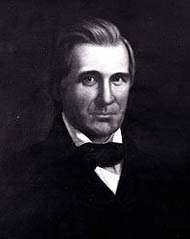 |
| Left: A page from the Law Department’s 1851 catalog. Above: The university’s first law professor, John Tayloe Lomax, who found it necessary to restructure law classes so students could attend just one session before entering practice. |
|
 The class of 1884, with professors Stephen O. Southall (center left) and John B. Minor (center right). Minor, a member of the law class of 1834, taught at the University for 50 years. |
Early Law Professors
The first law professor at the University of Virginia, John Tayloe Lomax, adopted Thomas Jefferson’s view that the study of law should include the study of government and politics within a broad conceptual framework.
Lomax responded to the needs of his students by restructuring the law course so that students could enter practice after completing only one session.
The second law professor, J.A.G. Davis, further modified Lomax’s division of the law program: the junior course included studies that “form an essential part of a liberal professional education” while the senior course was “exclusively occupied with the study of the theory and practice of the Law as a profession.”
 J.A.G. Davis published the first comprehensive treatment on Virginia criminal law. |
Davis served as chairman of the faculty from 1835 until his untimely death in 1840 when he was fatally shot by rioting students on the lawn.
Henry St. George Tucker resigned from the Virginia Court of Appeals to teach law at the University of Virginia. He developed a course of study that began with natural law, followed by the law of nations, principles of government and constitutional law, and municipal law.
In 1842, the University began awarding graduates in the School of Law, a Bachelor of Laws (LL.B.). The LL.B. remained in place until 1970 when the school conferred, in its place, the J.D.
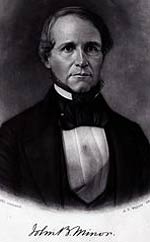 John Barbee Minor |
A new era of instruction was initiated with the hire of 1834 law graduate, John Barbee Minor in 1845. Minor remained at the helm of UVA Law for 50 years, retiring in 1895. A rigorous and demanding instructor, in Minor’s first ten years of teaching, a mere nine percent of his students were able to pass the exam and earn a Bachelor of Laws degree.
Minor’s experience as a legal practitioner influenced the way he structured his law courses, affording students the opportunity to combine practical skills with a systematic study of the concepts of law. Minor was persuaded to publish his Institutes of Common and Statute Law in 1875, cementing his reputation as the leading legal professor in the south.
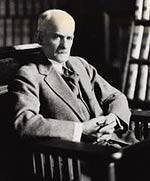 The first dean, William M. Lile, wrote “the student is taught that books are the working tools of the lawyer. …” |
William Minor Lile joined the law faculty in 1893 and became the first dean of the Law School in 1904.
During his 28 years as dean, Lile increased the years required for graduation to three, initiated publication of the Virginia Law Review, expanded the library, and oversaw the building of Clark Hall.
Like his predecessors, Lile continued to rely on lecture and examination to teach, resisting national trends towards the case method of instruction. “I trust that it is not the infirmity of age, nor narrow-mindedness, nor self complacency, and certainly not ignorance, that holds me loyal to the old system, but so I am.”
Introducing the Case Method
Armistead Mason Dobie is credited with first introducing the case method of instruction to Virginia. Dobie began teaching at Virginia in 1907. After military service in World War I, he attended Harvard to work on his S.J.D. There he was introduced to the case method and when he returned to Virginia in 1922, he began to use this approach in his law classes.
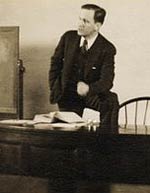 F.D.G. Ribble was the youngest man ever to teach at UVA Law. Arriving at the school in 1921, Ribble was lauded by Emerson Spies as a master of the Socratic method. |
F.D.G. Ribble was hired in 1921 and, at age 23, was the youngest man ever to teach at Virginia Law. Emerson Spies later described Ribble “as a master of the Socratic method.”
Another proponent of the case method, Hardy Cross Dillard, was hired as an assistant professor with Adolphus B. Scott right out of law school in 1927. In Lile’s Report to the President of the University for 1927, he states “two of the best graduates of last session, with the ink scarcely dry on their diplomas, were named as stopgaps for the new session . . . the choice proved a happy one.” Dillard would remain at Virginia until his retirement in 1968.
The Law faculty fully embraced the case method by the early 1930s. Despite Lile’s resistance to this approach he stated “the policy of the Law School has uniformly been to give each professor a free hand with respect to the particular method which he will follow in the teaching of his own courses.”
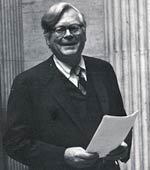 In 1970 Monrad Paulsen wrote, “In the future … law teachers will reach out for the understanding which other disciplines can provide.” |
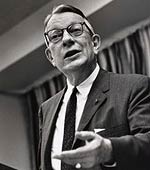 Hardy Dillard was described by colleague, T. Munford Boyd, as “a happy scholar.” |
 Charles Gregory came to UVA in 1949 from the University of Chicago. Extremely well liked by his students, upon his retirement students established a professorship in his name. |
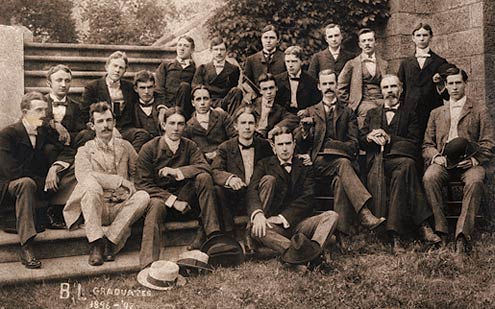 Law class of 1897, above, and 1898, below. |
||
 |
||
 Above: Law faculty in 1945. Right: Law Librarian Frances Farmer joined the Law community as an assistant to the dean and later became the first woman to teach in the Law School’s classrooms. Right, middle: A Richmond newspaper article describes Emerson Spies’ teaching technique: “As the professor paced across his stage, gesturing dramatically and using clever, often ridiculous examples to make his points humorously, members of his audience—all 150 of them—responded with complete attention and frequent laughter. It was a command performance by a veteran of the classroom/stage.” Right, bottom: A judge on the U.S. Court of Appeals for the Fourth Circuit, J. Harvie Wilkinson III ’72 taught law classes from 1973–1978, and again in ’83, before being appointed to the bench. |
 |
|
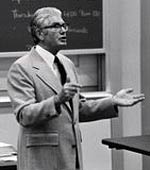 |
||
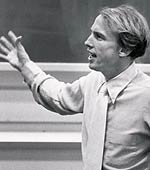 |
||
The law library in Clark Hall. |
||
Expanding the Curriculum
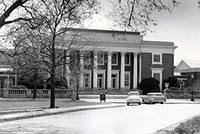 In 1932, the Law School moved to Clark Hall, built as a gift from William Andrews Clark, Jr., a member of the class of 1899. |
F.D.G. Ribble became dean of the Law School in 1939, a position he held until 1963. As dean, Ribble recognized important new areas of study such as labor law and enlarged the curriculum to include ‘Taxation, Administrative Law, and the whole range of business.”
Dillard, who succeeded Ribble as dean in 1963, proved to be a colorful, outgoing and beloved professor and administrator. He was described by colleague, T. Munford Boyd, as “a happy scholar.” In 1932, he taught the Law School’s first class in International Law.
 Garrard Glenn |
Garrard Glenn joined the law faculty in 1928, leaving a lucrative practice in New York City. Glenn’s business classes included Corporations, Trusts, Creditors’ Rights, Security and Insurance. Dobie was to claim in his later years that his greatest contribution to the Law School was his ability to persuade Glenn to come to Virginia.
Frances Farmer was the first woman to teach at UVA Law. Farmer earned her law degree from the University of Richmond and originally joined the law community to work for the dean. She became director of the law library after studying library administration at Columbia. In the 1940s she began teaching legal bibliography. When she retired as law librarian in 1976, Farmer was made professor emeritus.
From the time law classes began at the University, dozens of men and women have left their impressions on thousands of students. As the scope of legal education expanded so did the faculty—from one in 1826, to four in 1895, to fourteen in 1939. Today, more than 75 professors teach the Law School curriculum, which has developed rapidly and continues to encompass entirely new subject areas.
 |
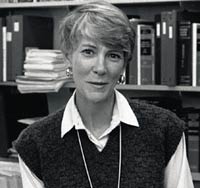 |
 |
| Left: In 1972, Larry Gibson was the first African American professor to teach at the Law School. Middle: Lillian BeVier was the first woman to become a full professor at the Law School. BeVier has taught constitutional law (with special emphasis on First Amendment issues), intellectual property (trademark, copyright), real property, and torts since her arrival in 1973. Right: In 1977, Samuel Thompson was the first African American full professor. | ||
 Above: A. E. Dick Howard Right, from top: Calvin Sharpe, Tom White, Richard Bonnie, and Neill Alford Below: Thomas Bergen Below Bottom: Robert Scott, left. |
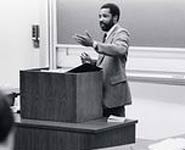 |
 |
|
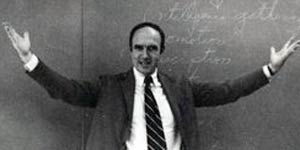 |
 |
|
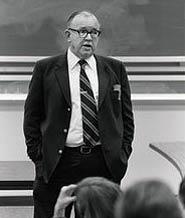 |
This article features only a few of the many formidable teachers who have graced the halls of the Law School. For a more complete retrospective, visit some of the exhibits on display in the law library or visit the Special Collections Department online from the library web page: www.law.virginia.edu/library.
Contributors:
Cecilia Brown and Denise Forster






